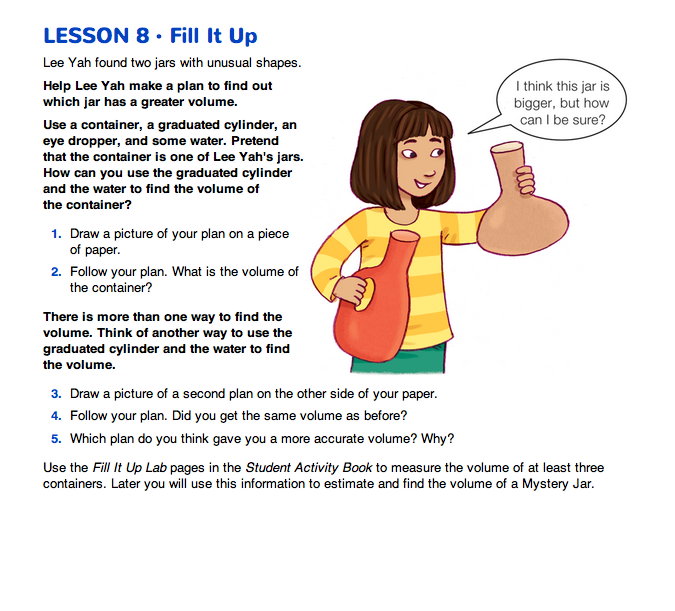Fill It Up
Est. Class Sessions: 3Developing the Lesson
Part 1. Launching the Investigation
Devise a Plan to Find Volume. Direct students' attention to the Fill It Up page in the Student Guide. Read the first 3 paragraphs together as a class. Students are asked to help Lee Yah make a plan to find out which of her containers has the larger volume. This launches the lab by allowing small groups of students to investigate different ways to find volume before they begin. Give all groups the same size container, so they can compare with each other to see how accurate they are. A good container for this is a large paper cup, about 2 to 3 times the size of their graduated cylinders.
Distribute a piece of plain paper, the container, a graduated cylinder, an eyedropper, and some water to each student group. Provide paper towels and possibly a dishpan to catch and clean up spills.
Repeat the question to focus the discussion:
Assign Question 1 to student groups. Students will talk with a partner or a group to devise a plan and draw a picture of it.
Present Plans. Ask groups to present their plans to the class. They will probably come up with at least one of two basic ways to measure volume:
- One way is to pour the water from the jar into the graduated cylinder and to count the number of times the graduated cylinder is filled. Any water left after the last complete fill can be poured into the graduated cylinder and easily measured.
- The second way is to pour water from the graduated cylinder into the jar and to count the number of times it takes to fill the jar. The amount left in the cylinder after the jar is filled is then subtracted from the full amount to determine how much was poured out the last time. For example, suppose 250 cc are poured from the graduated cylinder into the jar twice. Then the third pour fills the jar to the top with 70 cc remaining in the graduated cylinder. The volume of the container is 250 cc + 250 cc + (250 cc − 70 cc) = 680 cc.
The second method described is usually more accurate than the first method. Although the first method is a very natural way to measure the volume, it is likely to involve a lot of spilling, unless students are using containers such as bottles with narrow spouts where spilling would be minimal. Both methods use an eyedropper to set the level in the graduated cylinder at exactly 250 cc (or 100 cc if they are using the smaller graduated cylinders).
After student groups have presented their plans, compare the plans.
Ask:
Find the Volume Two Ways. Assign Questions 2–5 in the Student Guide. Remind students to be as accurate in their measuring as possible. For Question 2, students will follow their plan to find the volume of the container. For Questions 3–4, they will devise a second way to find the volume, draw another picture on the back side of their paper, and then find the volume of the container using this new plan. In Question 5 students are asked to compare the plans in terms of their accuracy in measurement.
Upon completion of the introductory exploration, discuss Question 5.
Ask:
Tell students they will be carrying out an investigation to find the volume of some containers.













